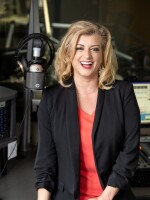Over three thousand kindergarten through sixth grade school children are seated at this magical open-air amphitheater in Santa Barbara. The stage at the Santa Barbara Bowl has hosted some of the biggest names in entertainment – but today – these youngsters are watching something a little bit different.
On stage are both able bodied dancers and dancers in wheelchairs. The dance company is called The Dancing Wheels Company. It was founded by Mary Verdi-Fletcher.
"I started Dancing Wheels 44 years ago. Way back then, people in wheelchairs didn't get a chance to dance. That's not very fair, is it?" she asked the audience.
"Nooooo," they replied, in unison.
Mary Verdi-Fletcher explained to KCLU how the dance company came to be.
"I was born with spina bifida, so it's a disability that alters the spinal cord. My mother was a professional dancer and my father was a musician. So they were my inspiration. I grew up just wanting to follow in my mother's footsteps and dance," she said.
"I just followed my dream to dance and made it possible for so many around the world to also be included in the world of dance."

Inclusivity is the theme of the day. From the stage, the dancers include the young audience in their routines. Playing with rhythm and graceful hand movements, the youngsters join in. For many here, it will be their first experience of the performance arts, says Rick Boller, the CEO of the Santa Barbara Bowl Foundation.
"Part of our mission is to support youth performing arts, and we find that this is a great way to have kids get introduced the facility and ultimately, hopefully become future audiences as well as artists," said Boller.
Being introduced to the arts isn’t a luxury, it’s a right – said Kai Tepper-Jahnke, the Executive Director of the Children’s Creative Project, who partnered to make this event happen.
"For a lot of these students, it's their first and maybe only time that they'll step foot at the venue. So it's a very exciting morning for all of us here," said Tepper-Jahnke.
"I think art has the power to really transform lives. It connects people of different backgrounds. It really transcends so much and brings people together in this inclusive environment. And it's the human emotion, right? So I think what I'm really looking forward to is giving this opportunity to students to experience not only this live dance performance in front of them, but to maybe see themselves potentially on stage someday, or just thinking about how to integrate movement into their everyday," she said.
The inclusivity of the show, and seeing that people in wheelchairs can also dance is something which struck a chord for the young audience here.
"What I like about this show is the fact that people in wheelchairs can actually, like, move around without messing up," said one.
"What I also like about the show is that people that can't walk and dance and move around, they believe in their self to do everything that they can do," said another.
So as well as an introduction to the performing arts, it was an opportunity to really see inclusivity in action, on a stage.



